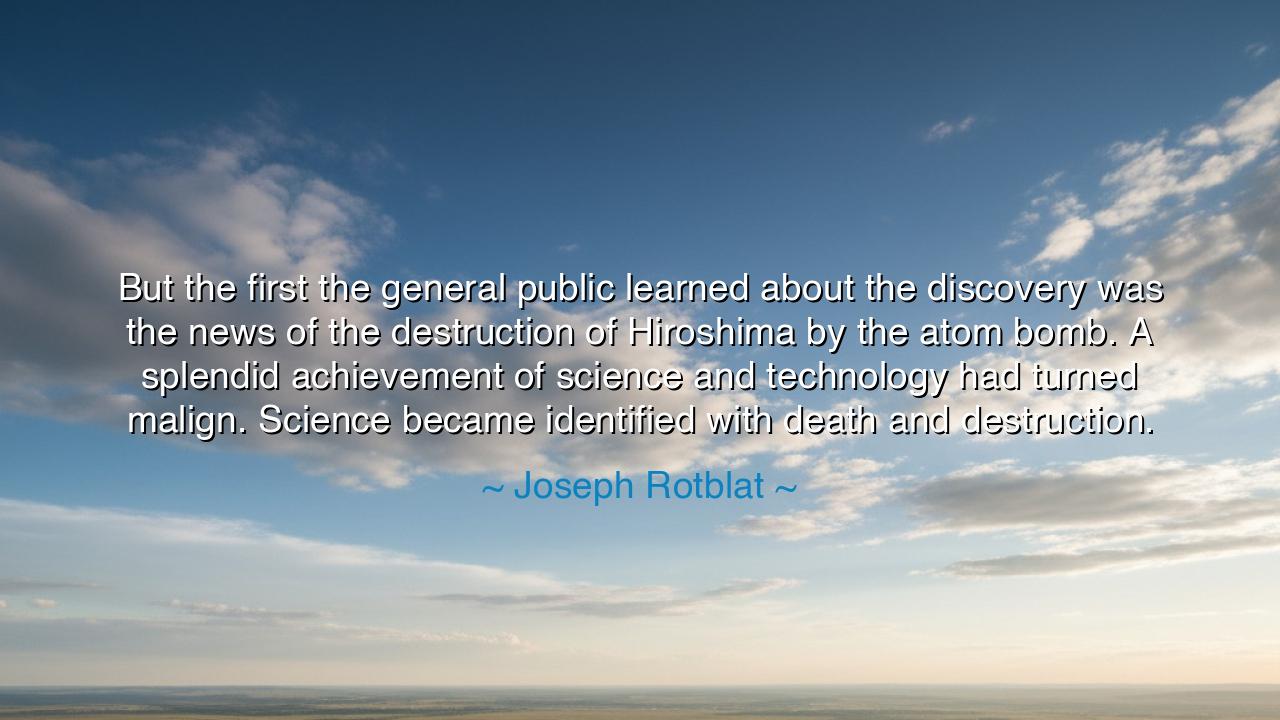
But the first the general public learned about the discovery was
But the first the general public learned about the discovery was the news of the destruction of Hiroshima by the atom bomb. A splendid achievement of science and technology had turned malign. Science became identified with death and destruction.






"But the first the general public learned about the discovery was the news of the destruction of Hiroshima by the atom bomb. A splendid achievement of science and technology had turned malign. Science became identified with death and destruction." These words from Joseph Rotblat carry with them a heavy truth, one that resonates through the fabric of history. Science and technology, once seen as the beacons of human progress and the means by which we would unlock the secrets of the universe, became forever intertwined with the dark forces of destruction and death following the tragic events at Hiroshima. The atom bomb, a creation of science, demonstrated humanity’s ability to harness the power of the universe, yet it also revealed the terrifying potential of that power when wielded for violence and war. What had once been a pursuit for the benefit of mankind now stood as a monument to its destructive potential.
In the ancient world, science and technology were seen as the keys to human advancement, yet the ancients were also deeply aware of the potential for these tools to be misused. Prometheus, the Titan who stole fire from the gods and gave it to humanity, is often seen as the ultimate symbol of the double-edged nature of discovery. Fire, while essential for survival, can also burn and destroy. In a similar vein, science—while capable of delivering incredible advancements—carries within it the possibility of misuse. The story of Prometheus is a warning about the responsibility that comes with knowledge, a theme that resonates in the wake of Hiroshima. When humanity gains the power to shape the world, it is not just the potential for good that must be considered, but also the capacity for evil.
The development of the atomic bomb during World War II represented the pinnacle of human ingenuity and the darkest twist of that ingenuity. The men and women who worked on the Manhattan Project—many of whom were driven by a desire to end the war and protect their countries—were unaware of the immense devastation their work would cause. Yet when the bomb was dropped on Hiroshima on August 6, 1945, the world witnessed firsthand the catastrophic consequences of scientific advancement used for destruction. The bomb’s creation had been heralded as a triumph of science; its use, however, marked a moment when science became forever associated with death, suffering, and war.
Consider the words of Albert Einstein, whose theories on relativity helped lay the groundwork for the atomic bomb, yet who later became an outspoken advocate for peace. Einstein himself regretted the role his work had played in the development of such a destructive weapon. In a letter to President Franklin D. Roosevelt, Einstein warned of the potential of nuclear weapons, but after seeing their use, he was left grappling with the reality that science—a field he had so deeply loved and dedicated his life to—had been turned to a weapon of mass destruction. Einstein’s regret is a reflection of the conflict that arose in the wake of Hiroshima—the realization that humanity had reached a point where its greatest achievements could also become its most dangerous tools.
The lesson from Hiroshima, then, is a sobering one. It is a reminder that science—though a force for good—is not without its moral and ethical responsibilities. Rotblat’s words call us to reflect on how we wield the power of knowledge and technology. While the discovery of the atom and the development of nuclear energy hold the potential for immense benefits—such as clean energy and advancements in medicine—these very discoveries also hold the power to destroy. The use of the atomic bomb stands as a reminder that science is not neutral. It is a force that can be shaped by the intentions of those who wield it. Hiroshima taught us that we must approach progress with a deep sense of responsibility, recognizing that the tools we create can either uplift or harm.
As we move forward into the future, we must ask ourselves: What is the purpose of our scientific discoveries? What will we do with the knowledge we uncover? In the same way that Socrates and Plato challenged their contemporaries to reflect on the moral dimensions of their actions, so too must we. The scientific community bears the responsibility to ensure that the tools it creates are used not for destruction but for the betterment of humanity. We must ask: How can we ensure that science serves the common good? How can we prevent the abuse of knowledge that has the potential to destroy rather than heal?
The lesson here is clear: science is a powerful force, capable of creating both wonders and destruction. The atomic bomb marks a turning point in history, a moment when science revealed both its immense potential and its terrifying capacity for harm. It is a reminder that the pursuit of knowledge must always be tempered with wisdom, ethics, and a deep commitment to the well-being of all humanity. Let us learn from the mistakes of the past, ensuring that our future discoveries are guided by the principles of peace, compassion, and responsibility. For the true triumph of science lies not in its ability to destroy, but in its power to enlighten, heal, and create a better world for future generations.






AAdministratorAdministrator
Welcome, honored guests. Please leave a comment, we will respond soon